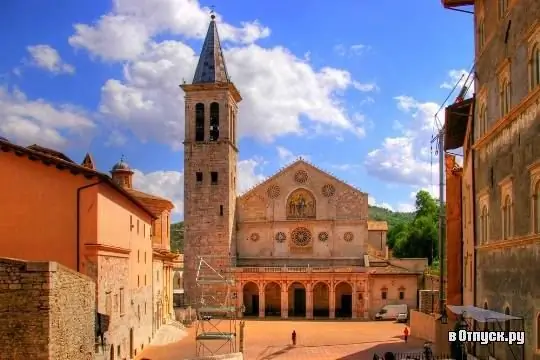
Description of the attraction
The Cathedral of Spoleto, named after Santa Maria Assunta, is the main church of one of the oldest cities in Umbria and the diocese of Spoleto Norcia, created in 1821. It is dedicated to the Ascension of the Mother of God.
The cathedral, with its central nave and side chapels crossed by a transept, is an excellent example of Romanesque architecture, albeit with some modifications. It was built in the second half of the 12th century on the site of the previous cathedral, which was destroyed by the troops of Frederick I Barbarossa. And in the 15th and 16th centuries, a remarkable outer portico and a bell tower were added.
The facade of the church is divided into three sections. The lower one is distinguished by an elegant entrance door with architrave and stucco pillars. Pulpits can be seen on both sides of the portico. The upper sections are separated from each other by rosette windows and pointed arches. The most notable detail of the façade is the mosaic of the blessing Christ, completed in 1207.
The interior of the cathedral was significantly changed in the 17th and 18th centuries. It has retained its original central nave floor, decorated in the unique cosmatesco style characteristic of medieval Italy and the frescoed apse. The images on it were made in 1467-1469 by Filippo Lippi and his students Fra Diamante and Piermatteo Lauro de Manfredi da Amelia: they painted scenes from the life of the Blessed Virgin Mary. The great Lippi himself is buried in the south wing of the transept.
Special attention should be paid to the altar cross by Alberto Socio, dated 1187, a Byzantine icon donated to the city by Barbarossa as a sign of reconciliation, and a fresco by Pinturicchio in the chapel of Bishop Eroli. In another chapel, other frescoes from the 16th century can be seen. The cathedral also houses a 14th-century multicolored wooden Madonna statue and a 16th-century choir with a painted altar and chapel. And under the Chapel of the Holy Gifts is the crypt of the former Cathedral of San Primiano.






